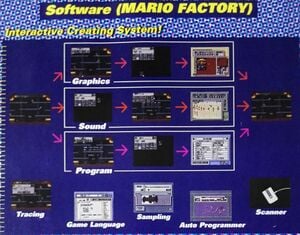User:Camwoodstock/Mario Factory
- These articles are a work-in-progress draft for an in-progress proposal, and should not be released into mainspace yet!!
Remember to remove this disclaimer, and un-comment the comments for navigation tools like navboxes and categories.
Significant things we want to account for before publishing are underlined; resolve these before publishing the page.
Also, if you wish to edit this, that's fine, but please run it by us in the Discord first.
Mario Factory
| Mario Factory | |
|---|---|
 A flyer depicting various screenshots of Mario Factory | |
| Developer | Nintendo |
| Publisher | Nintendo |
| Platform | Super Famicom |
| Release date | |
| Genre | Programming |
| Rating | N/A |
| Mode | Single Player |
| Format | |
| Input | Super NES: Have an image. Game Processor KeyboardMicrophone |
Mario Factory is a piece of software released for the Game Processor, a development kit released by Nintendo in 1994 for the Super Famicom. Mario Factory is a game-making program made for use with the Game Processor unit itself, and was controlled with two Super Famicom controllers, a Super Famicom mouse, alongside a keyboard created for the Game Processor, and had additional support for a microphone jack[3]. Mario Factory was loaded by way of a "Tool Disk", which was a 3.5" floppy diskette inserted into the front of the Game Processor[2]. From there, a RAM Cassette could be inserted into the cartridge slot on top of the unit, allowing for the saving and loading of games created using Mario Factory.
Game Modes
According to a flyer[4], the software featured three primary modes for creating and editing graphics, sound, and program code, alongside additional tools for tracing, sampling, and scanning, as well as an "Auto Programmer" which, according to Figure 16 of the patent, allowed for programming set paths in a manner similar to Mario Paint's animation tool. Software could be loaded and saved to dedicated "RAM Cassette" cartridges.
In a patent, Figure 5 depicts the title screen of the software, featuring Mario, Luigi, a woman, and an unknown bipedal creature, in a lobby with the text "Mario Factory" above it, with five options available. A "network icon" depicting a telephone, which allowed the user to upload or download files, a "tool box icon" which leads to the game editor, and a "game icon" which allows the user to play the loaded game. In addition, Figure 19 mentions two modes not apparent on Figure 5, a "Config Icon" which allows for configuring the Mouse and Keyboard, and a "File Icon" which may be the same as the "Load Model Software" section.
There are two forms of game editor, the "tool box" and the "game play" menu. From the tool box, the player could change game structure, sounds, program code, maps, and "unit"s (in-game entities), alongside listing an author. In the "game play" menu, the player could select an "object unit", and either edit its animations, its status, sound effects, and use the "Auto Programmer". Alternatively, they could select a "stage icon" and edit its music, status, data, "screen", and map, alongside a "unit screen editor".
Software
Mario Factory came bundled with a sample game, in the form of a port of Mario Bros. (game), the assets for which were later recycled for the Game Boy Advance version of Mario Bros.. In addition, a select few titles made with Mario Factory were later distributed as broadcasts on the Satellaview, such as Easy Racer.
Gallery
- We'd like to have a gallery featuring Figures 5, 6, 11, 14, 19, 20, and 21. Don't release the article until those are accounted for!
Notes
- Figure 6 depicts the ability to quickly switch between gameplay and editing software; a similar system would later be used in Super Mario Maker and Super Mario Maker 2, where the player can seamlessly go between editing a level and playing it.
- Figure 11 depicts a button very similar to Undodog.
- Figures 14, 15, and 15a depict a music editing tool that resembles the Music mode from Mario Paint, as well as the Music modes in the Super MakerMatic 21 in WarioWare: D.I.Y..
References
- ^ Luigiblood. GPC Documentation Page. Retrieved April 17, 2025.
- ^ a b Google Patents. Security systems and methods for a videographics and authentication game/program fabricating device. Retrieved April 18, 2025.
- ^ a b Google Patents. Videographics program/video game fabricating system and method. Retrieved April 17, 2025.
- ^ LuigiBlood. Here's a couple photos of a flyer that shows off the Game Processor and Mario Factory.. Retrieved April 17, 2025.
Game Processor
- This page is about the development kit. For other uses, see GP (disambiguation).
| Mario Factory | |
|---|---|
 Unit, as seen in a patent for Mario Factory We want this to be Figure 1B from US5680533A. | |
| Generation | Fourth generation |
| Release date | |
The Game Processor is a software development kit created and released by Nintendo, based upon the hardware of the Super Famicom. The Game Processor was created for use in universities, namely the HAL College of Technology & Design. The inspiration to create the Game Processor came from how Nintendo's own game development seminars were always overbooked, inspiring the idea to create a development kit for use in educational spaces.[2]
According to patents, it resembles an upright Super Famicom, but with four controller ports; two for standard controllers, one for the Super Famicom Mouse, and one for a special keyboard designed for the Game Processor. It has two slots, one for cartridges on the top of the unit, and one on the front of the unit for floppy disks. The Game Processor also has a microphone jack. Games could be saved and loaded from dedicated "Game Processor RAM Cassettes", which were battery-backed Super Famicom cartridges that could be read by being inserted into the cartridge slot. Internally, the Game Processor has a 32-bit "main" CPU, running alongside a Super Famicom "game" CPU. The computers would make use of superimposition to overlay the two video outputs, giving extra information that the Super Famicom CPU could not.[3]
The primary software for the Game Processor is Mario Factory, which was distributed as a "tool disk" for use in the floppy disk drive on the front of the console.[4] Mario Factory could save to and load from the Game Processor RAM Cassette cartridges.
Gallery
- Figure 1A from US5680533A, Figure 1C from US5599231A, and maybe a RAM Cassette too.
References
- ^ Luigiblood. GPC Documentation Page. Retrieved April 17, 2025.
- ^ April 1993. Mycom Basic Magazine. Mycom. Page 189.
- ^ Google Patents. Security systems and methods for a videographics and authentication game/program fabricating device. Retrieved April 18, 2025.
- ^ Google Patents. Videographics program/video game fabricating system and method. Retrieved April 17, 2025.
GP (disambiguation)
GP can refer to the following:
- Mario Kart Arcade GP, a sub-series of Arcade games as part of the Mario Kart series.
- Mario Kart Arcade GP, the original game in the Mario Kart series.
- Mario Kart Arcade GP 2, a numbered sequel to the original Mario Kart Arcade GP.
- Mario Kart Arcade GP DX, a follow-up to Mario Kart Arcade GP 2.
- Mario Kart Arcade GP VR, a virtual reality game in the Mario Kart series.
- Game Processor, a development kit for the Super Famicom released by Nintendo for use in universities.
- Grand Prix, a game mode in the Mario Kart series.